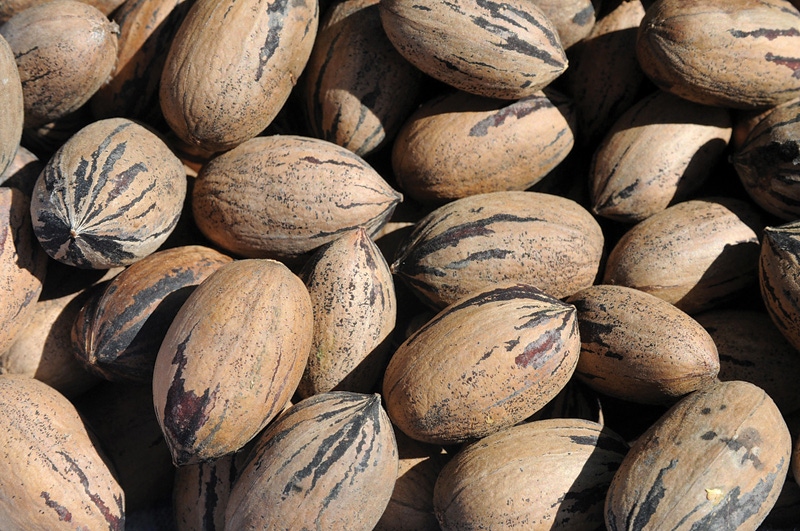
The Samuel Roberts Noble Foundation, the independent plant science research organization, says the decision window has passed for growers in the 14 pecan-producing states to spray for the first wave of pecan nut casebearer (PNC) moths this year.
But they are warning that the risk remains high for both resistant and native pecan trees in all Gulf Coast states and extending into other pecan states, and now is the time to be checking trees for additional pest development.
“The first generation of casebearers usually appears when pecans are young,” said Charles Rohla, Ph.D., assistant professor at the Noble Foundation. “This means they can destroy full crops before most producers realize there is even a crop on the tree.”
A check of the PecanipmPIPE interactive risk map for PNC this week confirms sightings across all of the 14 pecan-producing states. Producers can view the interactive map at http://pecan.ipmpipe.org/map/pnc/index.cfm.
The adult casebearer is a gray to almost black moth about 1/3 inch long. A ridge of dark scales followed by a band of lighter color runs across the fore-wings. Moths are active only at night, when they mate and lay eggs on pecan nuts. Each female lays 50 to 150 eggs during her 5- to 8-day life.
Eggs are oval, flat and tiny, just large enough to be seen with the unaided eye. When first laid, eggs are greenish-white or white. Tiny red spots soon appear on the egg, giving it a pink color before hatch. Casebearer larvae are olive-gray to jade green and grow to about 1/2 inch long.
According to a Texas AgriLife Extension publication, the pecan nut casebearer completes two to four generations a year. Overwintering larvae develop into moths that emerge in April and May and lay eggs on pecan nutlets soon after pollination. These eggs result in first-generation larvae, which feed on nutlets and generally cause the most damage.
Second-generation larvae attack the nuts in midsummer, about 6 weeks after first-generation larvae enter the nut. Third-generation eggs are deposited on nuts from late July to early September. These larvae feed only in the shucks if the pecan shells have hardened.
Many third and, if present, fourth-generation larvae do not feed but crawl to the base of a dormant bud where they build a tough, silken cocoon (hibernaculum) in which to spend the winter. In spring, these immature larvae leave their cocoons and feed by tunneling into shoots. Full-grown larvae pupate in shoot tunnels or in bark crevices. Moths from these overwintering larvae lay first-generation eggs on nutlets.
According to Rohla, the economic threshold to determine if a producer should spray or not is one damaged nut out of 310 clusters or if producers see one moth egg visible on a cluster. Additionally, groves that have experienced severe casebearer infestations have a higher likelihood of recurring outbreaks.
“Two years ago, we discovered that the moths overwinter in the trees,” Rohla said. “This means casebearers are already in the grove. A significant infestation one year potentially equates to a significant emergence the following year if left untreated.”
Cost-effective control
Controlling the moths is a fairly simple and cost-effective process. Most producers use Intrepid, a growth regulating chemical that does not damage beneficial insects. Intrepid lasts up to twice as long as other chemicals and also prevents infestation from other caterpillars that emerge later in the summer.
While most pecan growers are eager to control the casebearer, some use the moth to their advantage. The moth can aid producers during particularly heavy production years by thinning out the nuts, thus promoting healthy crops the following season. This year is shaping up to be one of those heavy production years with several trees showing extremely large crops.
Most casebearer eggs are found at the tip of the nutlet, either on the top (stigma) or hidden just under the tiny leaves (sepals) at the tip of the nutlet. You need a good hand lens to identify casebearer eggs and determine their development (hatched, white or pink). Also, look for bud feeding just below the nut cluster to detect the presence of newly hatched larvae.
In commercial operations, AgriLife Extension recommends many insecticides that are labeled for controlling pecan nut casebearer on pecan. Base your insecticide choice on applicator safety, grazing restrictions if livestock are present and potential impact of the insecticide on beneficial insects and other pests.
Thorough spray coverage, accurate timing to treat hatching larvae, using recommended insecticide rates, and proper sprayer calibration are critical for achieving good control of the pecan nut casebearer.
The use of pyrethroid (e.g., Asana, Ammo, Warrior) or carbaryl (e.g., Sevin) insecticides has sometimes been followed by outbreaks of aphids or spider mites in pecans. For this reason, using these insecticides for the pecan nut casebearer is discouraged, especially if the orchard has a history of aphid or mite problems. If you use pyrethroid insecticides, apply them no more than once per season.
Insecticide labels can change from year to year, so it is the user’s responsibility to follow current label directions for worker safety, grazing restrictions and application rates for target pests. Commercial growers should refer to E-125, “Managing Insect and Mite Pests of Commercial Pecan in Texas,” available at http://tcebookstore.org.
About the Author(s)
You May Also Like






